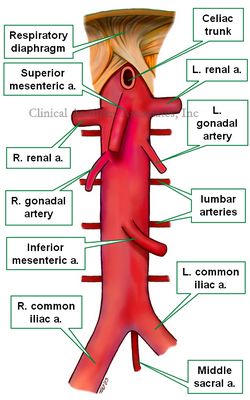The bifurcation of the aorta is the point at which the abdominal aorta ends distally. At this point the aorta bifurcates giving origin to the right and left common iliac arteries. These arteries trend anterolaterally towards the pelvic brim.
The aortic bifurcation is usually found anterior to the inferior border of the 4th lumbar vertebra vertebra, slightly to the left of the midline. In surface anatomy, the bifurcation corresponds to a point slightly left to the midline and just about two fingerbreadths (two centimeters) inferior to the umbilicus.
This is an important landmark in surface anatomy in laparoscopic surgery. When placing the first periumbilical trocar the surgeon must angle the trocar posteroinferiorly towards the pelvic basin as to avoid perforating or lacerating the abdominal aorta. This situation has been studied in many journal articles.
Inferior to the aortic bifurcation is the confluence of both common iliac veins which give origin to the inferior vena cava.
The middle sacral artery arises from the lower portion of the abdominal aorta and appears inferior to the aortic bifurcation in the midline an continuing on its way to the anterior aspect of the sacrum.
The fact that the aorta bifurcates in front of the 4th lumbar vertebra leaves the L5-S1 intervertebral disc free of major arteries (with the exception of the middle sacral artery) allowing surgeons access to the intervertebral disc to perform laparoscopic removal of the disc with implantation of a device to allow intervertebral fusion in the case of intervertebral disc disease.
Sources:
1. “Major vascular injuries during laparoscopic procedures” Nordestgaard, AG et al Am J Surg (1995) 169,5: 543–545
2. “Evaluation of the direct trocar insertion technique at laparoscopy” Byron. JW et al Obst Gyn (1989) 74:3, 423-425
3. “Open versus closed establishment of pneumoperitoneum in laparoscopic surgery” Bonjer, HJ et al Br J Surg, 84: 599–602
4. “Serious Trocar Accidents in Laparoscopic Surgery: A French Survey of 103,852 Operations” Champault G et al Surg Lap Endosc (1996) 6(5):367-70
5. “Major vascular injuries during gynecologic laparoscopy” Chapron CM et al J Am Coll Surg (1997) 185:5 461-465
Image property of:CAA.Inc.Artist: Victoria G. Ratcliffe




